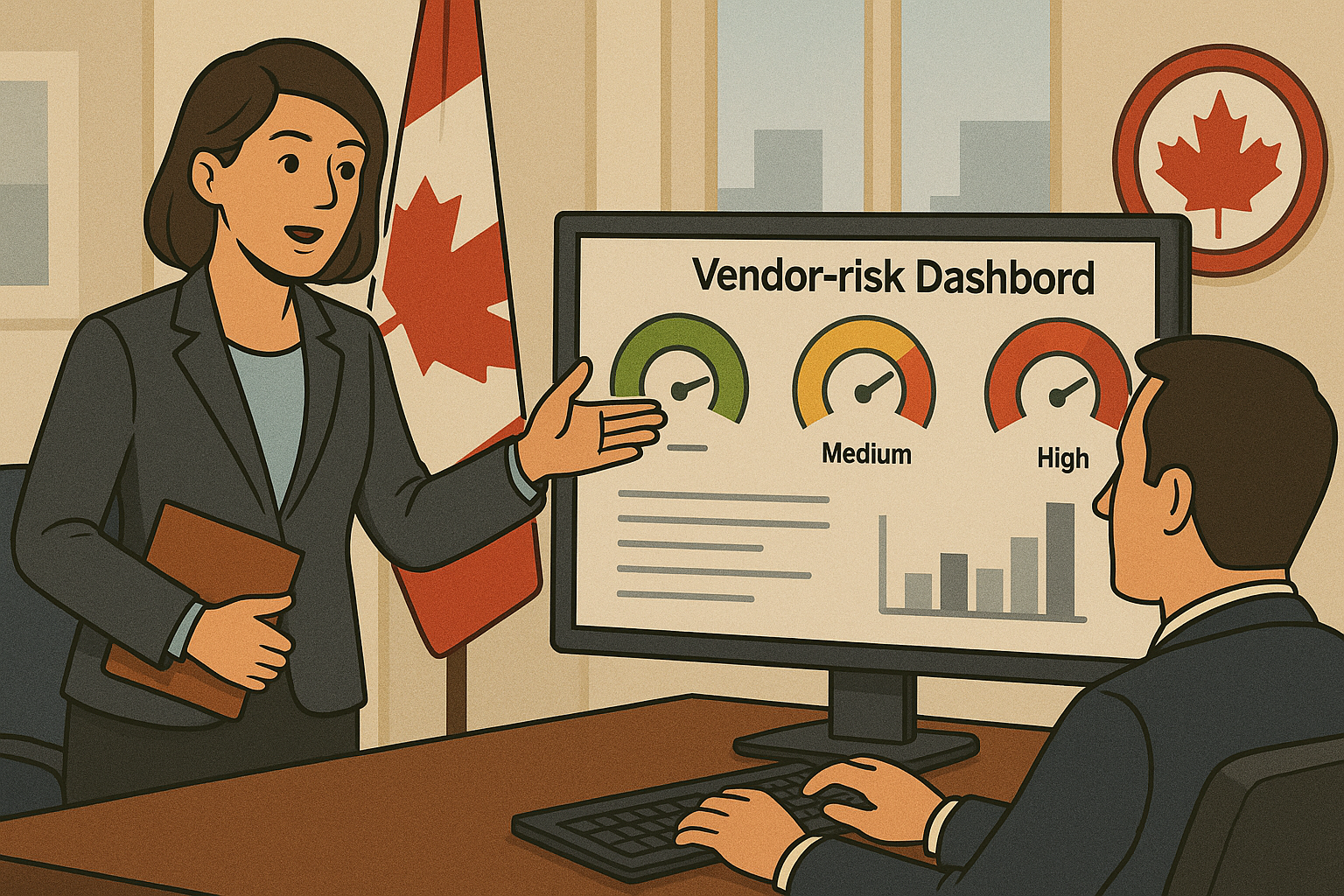Government Agency Adds Vendor-Risk Dashboard Service to Strengthen Supply-Chain Visibility
The Challenge
The Central Administrative Agency (CAA) began a modernization initiative with a clear objective: to improve transparency across its extensive network of third-party service providers that supported government operations. These vendors, ranging from IT service firms to facilities contractors, played a crucial role in day-to-day activities. However, as reliance on vendors increased, so did exposure to cybersecurity and privacy risks.
A quarterly compliance audit uncovered that one of CAA’s key cloud vendors had subcontracted several backend functions to firms operating outside Canada, without prior disclosure. These subcontractors had indirect access to non-classified yet sensitive data, including departmental directories and usage analytics. Although no confirmed breach occurred, the audit revealed a critical oversight: CAA’s vendor management and risk monitoring practices were outdated, fragmented, and largely manual.
In response, the Chief Information Officer initiated the design of an integrated Vendor-Risk Dashboard Service to centralize contract data, risk assessments, and compliance statuses. The dashboard was intended to provide real-time visibility into vendor-related risks, in line with PIPEDA and the Treasury Board’s Directive on Service and Digital, ensuring accountability for data handling across the supply chain.
During the design phase, deeper organizational challenges surfaced. Data about vendors was stored in disconnected systems, and procurement teams lacked consistent criteria for assessing cybersecurity and privacy controls. Many legacy contracts had been signed before modern security clauses were standard, leaving gaps related to data residency, encryption, and audit rights.
The impact extended beyond compliance concerns. Procurement delays increased as risk analysts manually verified vendor claims. Internal trust suffered as departments questioned the integrity of shared service providers. Informal memos circulated about the audit findings, heightening anxiety about reputational damage and potential parliamentary scrutiny.
By the time the plan for a unified risk dashboard was finalized, leadership recognized that the issue was not only technological but also cultural. The absence of centralized visibility had allowed vendor oversight to become complacent, turning external partnerships into potential liabilities. The lesson was clear: transparency across the third-party ecosystem is essential for compliance, trust, and operational resilience.
Our Solution
Our team implemented an Ancillary and Value-Adding Vendor-Risk Dashboard Service tailored for public-sector organizations. The service included:
– A complete vendor inventory linked to contracts, PIAs/TRAs, systems, and data flows.
– A standardized risk taxonomy and vendor tiering framework aligned with CSE ITSG-33, the Treasury Board Policy on Government Security, and departmental risk tolerances.
– Updated contractual standards covering data residency, subcontracting approval, encryption, incident notification timelines, audit rights, and data destruction procedures.
– Automated monitoring capabilities that gathered assurance evidence, SLA compliance data, exception logs, and real-time alerts.
– Structured governance processes that established escalation pathways to departmental privacy and security committees, with defensible audit trails.
This solution provided the agency with a centralized, evidence-driven view of vendor performance, security posture, and compliance readiness.
The Value
Within six months of implementation, measurable improvements were achieved:
– Vendor coverage in the central inventory increased from approximately 40% to more than 85%.
– Vendor onboarding time decreased by about 35% through standardized assessment workflows.
– Contractual risk gaps in legacy agreements were reduced by approximately 60% through systematic updates.
– PIA and TRA completion rates increased from 55% to 90% for in-scope data flows.
– Audit closure timelines improved by roughly 50% due to the dashboard’s evidence-based reporting.
– Executive visibility improved through quarterly reports on top vendor risks, enabling faster decision-making and risk acceptance.
These outcomes demonstrated clear operational, regulatory, and cultural benefits, establishing a sustainable framework for continuous third-party risk management.
Implementation Roadmap
1. Mobilization and Scoping (Weeks 0–2): Defined objectives, success criteria, and governance structure. Mapped all applicable frameworks including PIPEDA, the Privacy Act, Treasury Board directives, and ITSG-33.
2. Discovery and Baseline (Weeks 2–6): Consolidated vendor and contract data, identified subcontractors and data flows, and conducted initial PIAs and TRAs. Documented control gaps and compliance exceptions.
3. Design and Build (Weeks 6–12): Configured the dashboard data model, integrated it with procurement and IT systems, and developed automated risk and compliance workflows.
4. Policy and Contract Updates (Weeks 8–16): Applied standardized contractual clauses, prioritized high-risk vendors, and implemented new due-diligence questionnaires.
5. Pilot and Refinement (Weeks 12–18): Executed pilot tests with critical vendors to validate data accuracy, workflow efficiency, and dashboard functionality.
6. Rollout and Training (Weeks 18–24): Expanded deployment across departments and delivered targeted training sessions for procurement, privacy, and IT teams.
7. Continuous Improvement (Ongoing): Generated quarterly executive dashboards, tracked KPIs, and introduced periodic updates to contractual terms and control standards.


